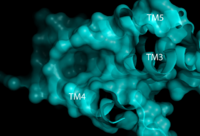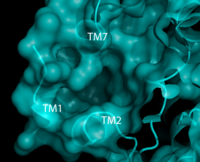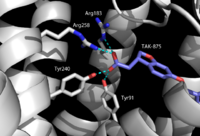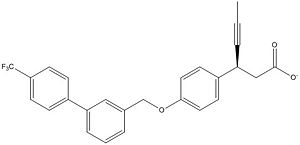Background
Human G-protein coupled receptor 40 (hGPR40), also known as free fatty acid 1 receptor (FFAR1), is a seven helical transmembrane domain receptor for long-chain free fatty acids.[1] Some known fatty acid substrates of hGPR40 include linoleic acid, oleic acid, eicosatrienoic acid, and palmitoleic acid[2]. This protein is primarily located in the pancreatic β-cells in the islets of Langerhans, and as such, it has become a target for potential Type 2 Diabetes treatments because hGPR40 stimulates insulin secretion.[3] Type 2 diabetes is especially relevant because the cells have become desensitized to insulin and free fatty acids. Activation of hGPR40 stimulates insulin secretion and decreases extracellular glucose concentration.[4] GPR40 is a member of a group of homologous GPCRs all located on chromosome 19q13.1 including GPCR41, 42, and 43.[5] Evidence exists that shows GPCR43 is involved in adipogenesis. GPCR41 was also previously believed to participate in adipogenesis, but this was shown to be false.[6]
Structure

Figure 1. Second proposed binding site of hGPR40 with surface shown. Substrate would bind in the deep pocket shown between TM3, 4, and 5.
Like most G-protein coupled receptors, hGPR40 contains (). To obtain a crystallized structure of the protein, four (, , , ) were made to increase expression levels and thermal stability of the protein. These mutations did not significantly impact the enzyme's binding affinity with a known agonist, TAK-875.[1] A (shown in crimson) was also added to intracellular loop 3 to aid in the formation of crystals. T4 Lysozyme also had little effect on TAK-875 binding.[1] For clarity, lysozyme is removed in all further renderings of hGPR40. hGPR40 also contains an extracellular loop that is conserved among most G-protein coupled receptors (ECL2). This loop has two subsections and is involved in the permeability of the binding site.
Binding Sites

Figure 2. Third proposed binding site of hGPR40 with surface shown. Substrate would bind in the pocket below TM7 and above and inbetween TM 1 and 2.
identified multiple
binding sites in hGPR40.
[1] Full agonists and
partial agonists were shown to bind in separate sites with positive
cooperativity.
[7] The has been identified, but other binding sites were hypothesized. TAK-875 binds between transmembrane helices 3, 4, and 5 and underneath ECL2. By visual inspection, a second possible binding site was proposed between transmembrane helices 3, 4, and 5 on the intracellular side of the transmembrane helices (Figure 1). The location of this binding site with respect to the membrane proposes that substrates would gain entry to the membrane by binding in this site. Also by visual inspection, a third possible binding site was proposed between transmembrane helices 1, 2, and 7 on the extracellular side of hGPR40, close to the TAK-875 binding site (Figure 2).
[1] These binding sites could potentially serve as regulation points for hGPR40. Many proteins that exhibit cooperativity are regulated by the binding of inhibitors.
Charge Network

Figure 3. TAK-875 with key binding residues Tyr91, Arg183, Tyr240, and Arg258. These residues all hydrogen bond to the carboxylate moiety of TAK-875.
hGPR40 has a distinct binding pocket that is established by : , , , , , , , and (all individual residues shown in
chartreuse). The importance of these residues for agonist binding was determined by alanine
mutagenesis studies. Each of these residues have either a
charged or polar R-group that creates a charge network that keeps these residues in a stable, unbound state until exposed to a substrate. When the substrate (an agonist) enters the binding pocket, four of the eight interact directly with the carboxylate moiety of the agonist by hydrogen bonding to it. These residues include two key arginines in the binding pocket, Arg183 and Arg258,
[8][9] and two key tyrosine residues, Tyr91 and Tyr240 (Figure 3). Tyr240 is especially important for binding, as mutation of Tyr240 caused an eight fold reduction in the binding affinity of TAK-875 and had a significant effect on the
KD of the protein.
[1]
ECL2
hGPR40 contains a highly conserved hairpin extracellular loop. This extracellular loop () is the longest and most divergent of the extracellular loops found in proteins (). The loop is accompanied by a disulfide bond () that forms between transmembrane helix 4 and the C-terminus of the ECL2 loop. In hGPR40, ECL2 has two sections: a beta sheet and an auxiliary loop. The beta sheet spans helices 4 and 5 and is shorter in hGPR40 than in other GPCRs. The ECL2 of hGPR40 also differs from that of other proteins because it contains an auxiliary loop of 13 extra residues. The entire extracellular loop has low mobility and flexibility which allows it to act as a cap for the binding pocket. The only exception to the low flexibility is the tip of the auxiliary loop, which corresponds to residues Asp152-Asn155. This area of greater mobility allows for substrates to enter the binding site.[1]
Function
hGPR40 functions as a free fatty acid receptor that participates in insulin signaling to regulate blood glucose concentrations. The actual mechanisms by which insulin signaling occurs are unknown, but multiple theoretical mechanisms have been posited for how hGPR40 participates in the regulation of glucose uptake.[1]
Mechanisms of Insulin Secretion
One proposed pathway of insulin secretion by hGPR40 involves the activation of the Gaq/11 protein complex. This complex then activates phospholipase C (PLC) which in turn hydrolyses phosphatidylinositol 4,5-bisphosphate to inositol 1,4,5-triphosphate (IP3) and diacylglycerol (DAG). IP3 can then mediate the influx of Ca2+ by moving into the cytoplasm, binding to the endoplasmic reticulum, and allowing for the release of Ca2+ into the cytosol.[5] This increase in [Ca2+] amplifies the similar increase in [Ca2+] that results from high concentrations of glucose. In this way, hGPR40 mimics glucose dependent insulin secretion.[10] Overall, hGPR40 helps to amplify the Ca2+ signal so that the cell secretes more insulin.
Another pathway through which hGPR40 may induce insulin expression is through phospholipase D1 (PKD1). When free fatty acids bind to hGPR40, hGPR40 directly phosphorylates and activates PKD1. The PKD1 plays a role in controlling the organization of an actin network that plays in role in insulin secretion.[5]
Clinical Relevance
By signaling predominantly through Gaq/11, hGPR40 increases intracellular calcium and activates phospholipases to generate diacylglycerols resulting in increased insulin secretion. Synthetic small-molecule agonists of hGPR40 enhance insulin secretion in a glucose dependent manner in vitro and in vivo with a mechanism similar to that found with fatty acids. hGPR40 agonists have shown efficacy in increasing insulin secretion and lowering blood glucose in rodent models of type 2 diabetes.[5]
TAK-875

Figure 4. Structure of TAK-875. The carboxylate moiety (upper right) inserts into hGPR40. The Sulfonate group (upper left) remains on the outside of the protein once bound.
One example of an hGPR40 agonist is . The carboxylate moiety of the agonist enters through the auxiliary loop of hGPR40, disrupts the hydrogen bonding of the charge network, and binds with Arg183, Arg258, Tyr91, and Tyr240.
[1] TAK-875 has shown efficacy in increasing insulin secretion and lowering blood glucose in rodent models of type 2 diabetes.
[5] This drug was studied in
phase III clinical trials. It significantly reduced
HbA1c and fasting plasma glucose levels in Japanese patients with type 2 diabetes that was not controlled by diet and exercise. However, clinical trials were stopped shortly after this study because TAK-875 was suspected of causing liver damage.
[11]
Other Potential Inhibitors

Figure 5. Structure of the potential agonist AMG-837. In clinical trials, this drug was found to increase glucose tolerance in individuals with Type 2 Diabetes.
TAK-875 had the most promising outlooks out of any current known agonists of hGPR40, but it was discontinued. Some other agonists tested in clinical trials include AMG-837 and AM-1638. When coadministered, AMG-837 (Figure 5) and AM-1638 enhanced glucose tolerance, but they were found to be toxic in the human trials. Some other agonsits are currently being examined as well. One compound, LY 2881835 (Eli Lilly & Company, Indianapolis, IN), has undergone clinical trials, but the results are unknown. In addition to the above-mentioned compound, other orally bioavailable GPR40-specific agonists are currently in preclinical or clinical development. As of 2015, TUG-770 and CNX-011-67 (Connexios Life Sciences, Karnataka, India) were in preclinical trials and JTT-851 (Japan Tobacco, Toyko, Japan), and P11187 (Piramal, Mumbai, India) were in clinical trails.
[12]





